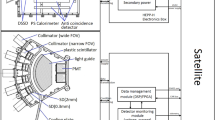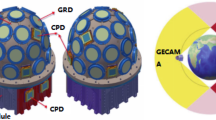Abstract
The space environment monitor (SEM) aboard FY-2 satellite consists of the high energy particle detector (HEPD) and the solar X-ray flux detector (SXFD). The SEM can provide real-time monitoring of flare and solar proton event for its operation at geostationary orbit and is also the first Chinese space system for monitoring and alerting solar proton event. During the 23rd solar maximum cycle, almost all the solar proton events that took place in this period are monitored and some of them are predicted successfully by analyzing the characteristics of X-ray flare monitored by the SEM. Some basic variation characteristics of particle at geostationary orbit are found such as day-night periodic variation of particle flux, the electron flux with energy >1.4 MeV in the scope from 10 to 200/cm2.s.sr and the proton flux with energy >1.1 MeV in the scope from 600 to 8000/cm2.s.sr during the time with no magnetic storm and solar eruption.
Similar content being viewed by others
References
Space Studies Board, Radiation and the International Space Station, Washington DC: National Academy Press, 1999, 7–21.
Turner, R., Solar particle events from a risk management perspective, IEEE Transactions on Plasma Science, 2000, 28(6): 2103–2113.
Babayan, V. K., Bostanjyan, N., Chilingarian, A. A., et al., Alert service for extreme radiation storms, Proc 27th ICRC, in Hamburg, 2001, vol. 9, 3541–3544.
Cane, H. V., Reames, D. V., McGuire, R. E., et al., Solar flare nuclear gamma-rays and interplanetary proton events, The Astrophysical Journal, 1989, 343: 953–970.
Cliver, E. W., Dennis, B. R., Kiplinger, A. L. et al., Solar gradual hard X-ray bursts and associated phenomena, The Astrophysical Journal, 1986, 305: 920–935.
Lin, H. A., Wang, S. J., The radiation characteristics of solar proton event X-ray flare and solar proton event alert. The Journal of Space Science, 1993, 13(2): 122–128.
Author information
Authors and Affiliations
Corresponding author
Rights and permissions
About this article
Cite this article
Zhu, G., Li, B., Wang, S. et al. The space environment monitor aboard FY-2 satellite. Sci China Ser G: Phy & Ast 48, 26–32 (2005). https://doi.org/10.1007/BF02736583
Received:
Issue Date:
DOI: https://doi.org/10.1007/BF02736583




